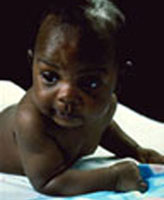 |
As stated previously, the symptoms of AHT can vary from mild to death depending on the specific injury that is sustained by the child. Some of the consequences of AHT include the following (NCSBS, nd):
- Irreversible brain damage
- Learning disabilities
- Physical disabilities
- Retinal hemorrhage, visual disabilities, blindness, eye damage
- Hearing impairment, hearing loss
- Speech disabilities
- Cerebral palsy
- Spinal cord injury
- Paralysis
- Seizures
- Behavior disorders
- Cognitive impairment
- Death
In comparison with accidental traumatic brain injury in infants, those with AHT injuries have a much worse prognosis. Damage to the retina of the eye can cause blindness. The majority of infants who survive severe shaking will have some form of neurological or mental disability, such as cerebral palsy or mental retardation, which may not be fully apparent before 6 years of age (NINDS, 2010).
Hymel, et al. (2007) compared subjects with noninflicted head trauma with subjects with inflicted head trauma and reported that those with inflicted head trauma had:
- More frequently experienced noncontact injury mechanisms,
- Sustained greater injury depth,
- More frequently manifested acute cardiorespiratory compromise,
- Had lower initial Glasgow Coma Scale scores,
- Experienced more frequent and prolonged impairments of consciousness,
- More frequently demonstrated bilateral, hypoxic-ischemic brain injury,
- Had lower mental developmental index scores 6 months postinjury, and
- Had lower gross motor quotient scores 6 months postinjury.
Clearly, many of the long term consequences have a profound impact on the child as well as on families, communities and societies. The severe disabilities that AHT can cause require multiple supportive services from multiple sources. Many children require long-term medical services, physical, occupational, speech, and educational therapies, and lifelong custodial care (NINDS, 2010; Dias, et al., 2005). Social and educational services are also needed.
As stated previously, the medical costs associated with initial and long-term care for children who are victims of AHT can be very high. Additional costs associated with loss of societal productivity and occupational revenue and with prosecution and incarceration of a perpetrator are unknown (Dias, et al., 2005).
 |
| Ken Hammond, USDA |
Continue on to
|
 |